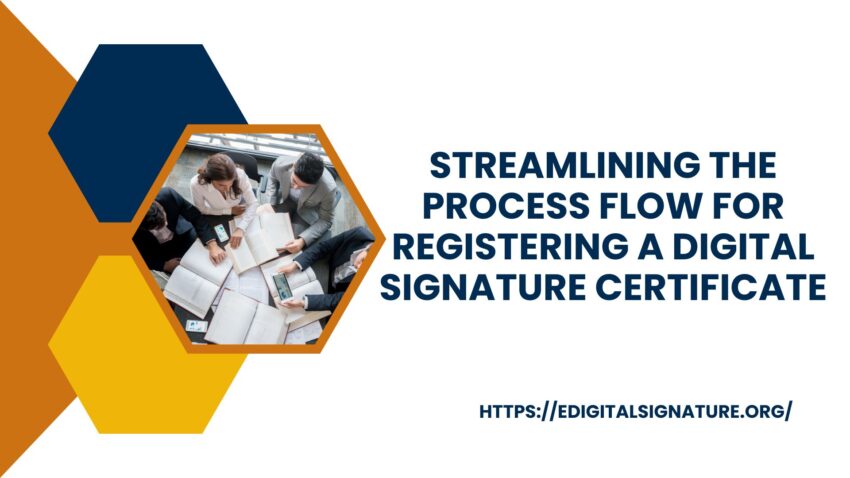Introduction
In today’s digital era, secure and efficient authentication of documents and transactions has become essential for businesses and individuals alike. One such powerful tool for ensuring the authenticity of digital documents and ensuring data security is the Digital Signature Certificate (DSC). A Digital Signature Certificate is an electronic form of identification that confirms the authenticity of the sender of a message or document and verifies their identity electronically. This certificate plays a crucial role in various online processes, such as e-filing of taxes, online banking, government applications, and more.
In this article, we will delve into the step-by-step process flow for registering a Digital Signature Certificate, exploring the requirements, necessary documents, and the procedure involved.
Step 1: Determine the Type of Digital Signature Certificate
Before starting the registration process, you must identify the type of Digital Signature Certificate required for your specific needs. There are three types of DSCs available:
- Class 1: Used for securing email communication and verifying the authenticity of the sender. It is ideal for individuals and private entities.
- Class 2: More advanced than Class 1, this certificate is used for online transactions, filing Income Tax Returns (ITR), and other government-related activities. It is suitable for directors, signatories, and other authorized personnel of companies.
- Class 3: The highest level of DSC, it offers the highest level of security and is mainly used for participating in online tenders, e-auctions, and similar activities requiring utmost authentication.
Step 2: Choose a Licensed Certifying Authority (CA)
A Certifying Authority is an entity that issues Digital Signature Certificates after validating the applicant’s identity. It is crucial to select a licensed and authorized CA to ensure the certificate’s legitimacy. Visit the website of the Controller of Certifying Authorities (CCA) to find a list of accredited CAs.
Step 3: Gather the Required Documents
To register a Digital Signature Certificate, you need to provide certain documents depending on the type of DSC and the entity for which it is being issued. Generally, the following documents are required:
For Individuals:
- Proof of Identity (Aadhar card, passport, voter ID, etc.)
- Proof of Address (utility bills, bank statements, etc.)
- Passport-size photographs
For Organizations:
- Certificate of Incorporation (for companies) or Registration Certificate (for other organizations)
- Memorandum and Articles of Association (MOA & AOA)
- Proof of Identity and Address of the authorized signatory(ies)
Step 4: Filling the Digital Signature Certificate Application
Once you have gathered the necessary documents, visit the website of the chosen Certifying Authority and locate the Digital Signature Certificate application form. Fill out the form with accurate details, ensuring that all information matches the submitted documents.
Step 5: Verification of Documents
After submitting the application form online, you may need to visit the CA’s office in person or through a registered authority for document verification. During this step, the CA will cross-check the submitted documents with the information provided in the application form.
Step 6: Payment of Fees
To obtain a Digital Signature Certificate, you must pay the required fees as specified by the Certifying Authority. The fees vary based on the type of DSC and its validity period. Make the payment through the designated online payment methods.
Step 7: DSC Issuance and Installation
Once the verification is successful and the payment is confirmed, the Certifying Authority will issue the Digital Signature Certificate. It will be sent to the applicant’s registered email address or stored on a cryptographic USB token device. Follow the provided instructions to install the certificate on your computer system or token device securely.
Step 8: Usage and Renewal
With your Digital Signature Certificate installed, you can now use it for various online transactions and document signings. However, remember that the certificate has a limited validity period (usually one or two years). Before it expires, you must initiate the renewal process through the same CA to continue using it without interruptions.
Suggested Read: Digital Signature Certificate for Income Tax
Conclusion
The process flow for registering a Digital Signature Certificate is a systematic and essential procedure to ensure the authenticity and security of digital transactions. By selecting the appropriate type of DSC, choosing an accredited Certifying Authority, and providing the necessary documents, individuals and organizations can streamline the registration process and leverage the power of digital signatures in today’s rapidly advancing digital world. Embracing the use of Digital Signature Certificates not only enhances the credibility of online communications but also contributes to creating a secure and trustworthy digital ecosystem.


